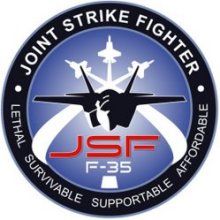|
||||||||||
|
|
||||||||||
|
||||||||||
|
|
||||||||||
 - -
 - -
|
|

|
Boeing or Lockheed Martin Joint Strike Fighter Multi-Role Fighter |
|
DESCRIPTION:
The Joint Strike Fighter program was begun to replace a myriad of aircraft for the US Air Force, US Navy, US Marines, and the British Royal Navy beginning around 2010. Since each branch hoping to acquire the JSF has different needs, each variant of the aircraft is tailored to the requirements of that service. The USAF plans to acquire a conventional takeoff attack fighter variant to replace the F-16 and A-10 while the Navy and Marines need to replace older models of the F/A-18. The Navy version is generally similar to the Air Force model but carries more fuel for greater range. The Marine Corps also needs a short takeoff/vertical landing (STOVL) aircraft to replace its fleet of AV-8B Harriers, so its version features a ducted lift-fan to assist in vertical flight. The Royal Navy similarly plans to purchase a STOVL model to replace the Sea Harrier while the Royal Air Force hopes to replace its Harrier II fleet. The origins of the JSF project can be traced to 1983 when the Defense Advanced Research Projects Agency (DARPA) began studies of technologies to build a supersonic replacement for the Harrier. The project eventually became a combined US and UK study called ASTOVL, for Advanced Short Take-Off/Vertical Landing. The simplest technique explored by ASTOVL was the addition of plenum chamber burning to each of the Harrier's four rotating nozzles. Although a supersonic "Super Harrier" concept was proposed, the plenum chambers were rejected due to problems with ground erosion and hot gas being reingested by the engine. The study also eliminated other advanced thrust vectoring approaches as being too complicated, too heavy, or too risky. Beginning in 1987, ASTOVL created a highly-classified program known as the STOVL Strike Fighter (SSF). SSF was largely a partnership between Lockheed Skunk Works and NASA Ames Research Center to explore advanced technologies for a stealthy, supersonic STOVL aircraft. This research concluded that such a plane could be built, and Lockheed successfully convinced both the US Air Force and US Marine Corps to support additional work potentially leading to a production model. As participation of the services grew, the ASTOVL program again morphed into a larger effort called the Common Affordable Lightweight Fighter (CALF) in 1993. The purpose of CALF was to propose options for a multi-service aircraft including a conventional variant for the Air Force and Navy as well as a vertical flight version for the Marines and Royal Navy. In addition to Lockheed, McDonnell Douglas and Boeing were contracted to participate in CALF to explore a variety of fighter and propulsion concepts for a future multi-role combat plane. Although CALF focused primarily on development of a supersonic STOVL aircraft, both the US Air Force and US Navy had other programs underway to explore future combat aircraft. The USAF had begun the Multi-Role Fighter (MRF) project in 1990 forseeing the need to develop a low-cost replacement for the F-16. Several major aircraft manufacturers developed proposals meeting the MRF requirements, but the project was cancelled owing to defense cutbacks following the end of the Cold War. The Navy, meanwhile, had begun the Advanced Tactical Aircraft (ATA) program, creating the deeply troubled A-12 Avenger, as well as the Naval Advanced Tactical Fighter (NATF) that considered developing a carrier-borne derivative of the F-22. Following cancellation of the A-12, the Navy began the Advanced-Attack (A-X) project in 1992 to develop a replacement for the A-6. Cancellation of the NATF led to increasing air-to-air requirements for the A-X and it evolved into the Advanced/Fighter-Attack (A/F-X) project. Five contractor teams were invited to participate in A/F-X. Both the MRF and A/F-X were cancelled in 1993, and the services were directed to merge their requirements into a new effort called the Joint Advanced Strike Technology (JAST) project. The primary goal of JAST was to study the feasibility of a joint combat aircraft for both the Air Force and Navy. Looking to save additional money, Congress also directed ASTOVL/CALF to be merged into JAST in 1994. JAST was later renamed Joint Strike Fighter (JSF) in 1996 with the goal of developing a common aircraft for the USAF, USN, USMC, and Royal Navy. The British counterpart to JAST and JSF began in 1996 as the Future Carrier Borne Aircraft (FCBA) program intended to replace the Royal Navy's Sea Harrier fleet. Once the Royal Air Force joined in 2001, FCBA became the Future Joint Combat Aircraft (FJCA) and later simply the Joint Combat Aircraft (JCA). Since the designation X-32 had already been set aside for a CALF STOVL demonstrator and X-35 for an advanced fighter demonstrator, these were reallocated to two Joint Strike Fighter demonstrators to compete for a production contract. Manufacturers began considering design concepts in 1994 and the official request for proposals was released in 1996. The three design teams expressing interest included:
Nonetheless, the Lockheed X-35 design was judged superior in 2001, and the company began additional development leading to full production of an operational fighter to begin entering service in the early 2010s. For detailed information on each of the competitors, see the Boeing X-32 and Lockheed Martin X-35 as well as the F-35.
Last modified 21 February 2011
|
|
SOURCES:
|


|
Aircraft | Design | Ask Us | Shop | Search |

|
|
| About Us | Contact Us | Copyright © 1997- | |||
|
|
|||